
Score breakdown
Things we like
- Punchy plug-in hybrid powertrain
- Very useful all-electric range
- New infotainment technology
- Comfort and features
Not so much
- 7kW battery-charging limit
- Run-flat tyres
- Vagueish steering
- Only available in F Sport spec
Lexus isn't new to electrification, with hybrids making up about 40 per cent of its Australian business including 56 per cent of UX crossover sales, which now include the UX300e, the brand's first battery-electric vehicle (BEV).
Now the Japanese luxury carmaker has entered the plug-in hybrid (PHEV) market with the 2022 Lexus NX 450h+ that headlines the all-new NX medium-SUV range.
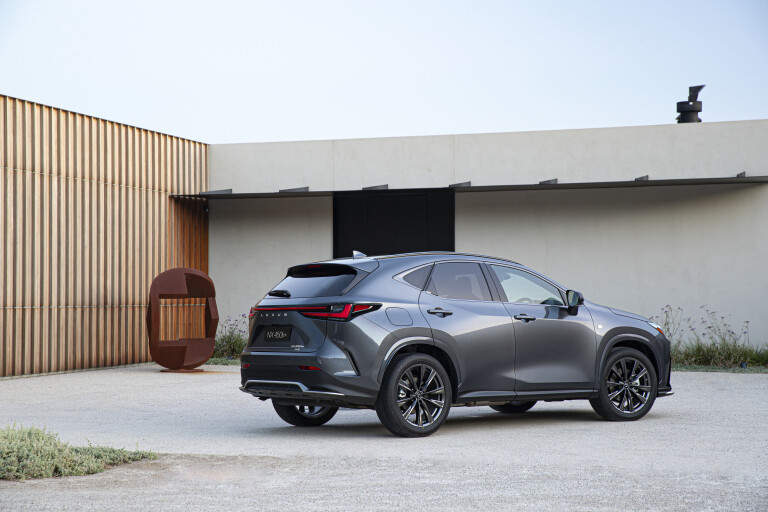
With plug-in hybrids seen by many as a stop-gap measure on the path towards full electrification, this is an interesting move by Lexus. However, it's not without merit.
Pricing and Features
The Lexus 450h+ is only available in the upper-spec F Sport to trim resulting in a relatively high starting price of $89,900 before on-road costs. That's some $20,000 more than the entry-level petrol NX250.
A better comparison is against the AWD F Sport variants, the NX350 and NX350h, which are both priced from $77,900 before on-road costs.
Looking outside the Lexus stable, the 450h+ bridges the price gap between mainstream PHEV SUVs and its closest premium rivals, such as the Mercedes-Benz GLC300e and Volvo XC60 Recharge, which are priced from $95,700 and $109,908 respectively.
Like the other F Sport variants, the 450h+ comes with auto-levelling tri-beam LED headlights, leather-appointed upholstery with a choice of colours, eight-way power-adjustable and heated and ventilated front seats, dual-zone climate control, heated self-dimming door mirrors and smart keyless entry/start.

There's also the new E-Latch electronic door handles, a powered tailgate, Tazuna cockpit driver display with 8.0-inch digital gauge cluster, a 14-inch touchscreen, cloud-based connected satellite navigation, Apple CarPlay/Android Auto, DAB+ digital radio, 10-speaker audio and a drive mode selector offering Eco, Normal and Sport settings.
F Sport-specific kit includes adaptive variable suspension (AVS) and performance dampers, Sport S+ and Custom drive mode settings, 20-inch wheels, and bespoke grille, bumpers, sports seats, pedals, scuff plates, steering wheel and gear selector.
As well as the plug-in hybrid powertrain and associated equipment, the NX450h+ comes with a sunroof, digital rear-view mirror and a heated steering wheel, which are optional extras on the NX350 and NX350h F Sport.

The entire 2022 NX line-up comes with complimentary access to Lexus' expanded connected services technology including a smartphone app with automatic collision notification, SOS emergency call, stolen vehicle tracking and the ability to remotely operate the door and boot locks, turn the engine off and off, activate the horn, turn on the headlights and hazards and set the climate control.
In addition, NX450h+ buyers get a free 7kW AC home charger with installation and three years of complimentary membership of the Lexus Encore Platinum owner benefits program.
The 2022 Lexus NX450h+ is covered by a five-year, unlimited-kilometre warranty. Service intervals are every 12 months or 15,000km.
Comfort and Space
There isn't much inside the NX450h that sets it apart from other F Sport variants apart from PHEV-related functions and the quieter ride when driving in EV mode.
Its plug-in powertrain is one of a number of new technologies that are making their Lexus debut in the second-generation NX.
These include the e-latch door openers that use pressure switches instead of mechanical handles, which on the outside work a lot like those on the tailgates of most recent models.

From the inside, opening the door requires a gentle push of the latch. This seems a little gimmicky at first, but the system offers the safety benefit of not operating if it senses you're about to open the door into the path of another vehicle or cyclist – Lexus calls this Safe Exit Assist.
Everything is well put together, as you'd expect from Lexus, with the F Sport sport seats providing excellent back, hip and bum support.
The new cabin design is a lot less cluttered than before, especially on the centre console that has fewer buttons and dials, with the bulky trackpad infotainment controller thankfully being given the boot.
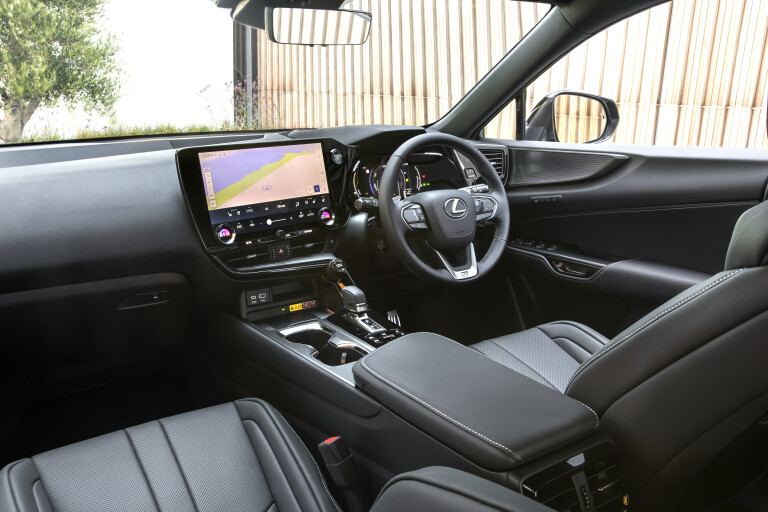
Most functions are now controlled from the touchscreen or the steering wheel, though there are a few physical controls for driving functions near the gear selector. The result is a much cleaner interface, with the touchscreen and HVAC controls floating in front of the dashboard within a piano-black fascia that merges with the digital gauge cluster.
Not surprisingly, Lexus has a name for this – the 'Tazuna' cockpit concept, with the moniker derived from a Japanese term that describes the connection between a horse and rider through the reins.
As with most steering wheels on newer cars, this one has buttons to operate active cruise control and lane-keep assist on one side, and other functions such as phone and audio on the other.

But Lexus has cleverly displayed those functions directly in front of the driver on the head-up display (HUD), so you don't have to look down at the steering wheel.
It's a little fiddly at first but once you get used to it it's quite handy. The buttons respond to gentle touching or swiping but you can set them so they have a more haptic feel.
The Tazuna cockpit also features Lexus' new-generation multimedia system that in F Sport variants is displayed on a class-leading 14-inch touchscreen.
It's simple to negotiate and doesn't require swiping through different screens to find what you need. It has one of the better in-built sat-nav systems too, with an integrated data communication module (DCM) to provide cloud-based navigation info and other information such as live traffic updates and parking locations.
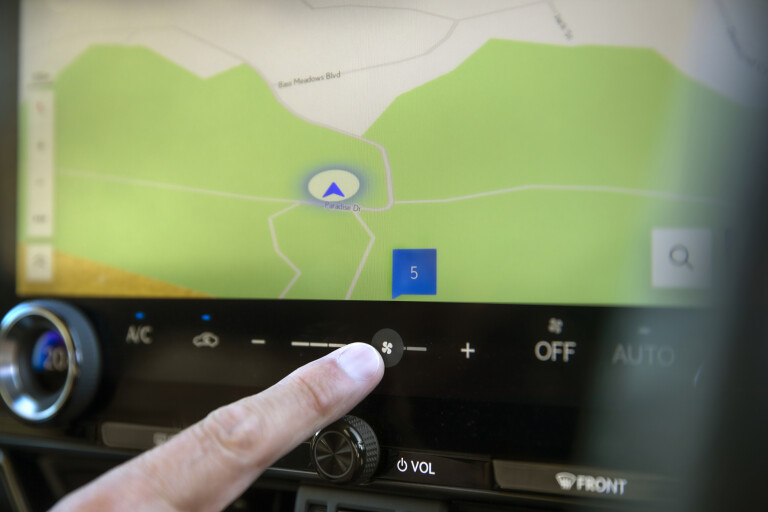
You can use your favourite navigation app via Android Auto or Apple CarPlay, but you don't get the benefit of directions being displayed at eye level in the HUD.
The touchscreen is also where you'll find most of the air-conditioning controls as well as the heated/ventilated seat settings. These buttons are always on display so you don't have to swipe into a menu to find them. Setting the fan speed on a touchscreen can be quite fiddly on the move, but I didn't have much trouble with this interface.
Pleasingly, Lexus has kept a couple of big dials for the temperature controls along with a volume knob. But if you can't be bothered with touching anything, the new NX comes with an advanced voice control system called 'Hey Lexus' that works very much like its 'Hey Mercedes' counterpart to operate navigation, phone, climate control and certain vehicle functions such as opening the windows.
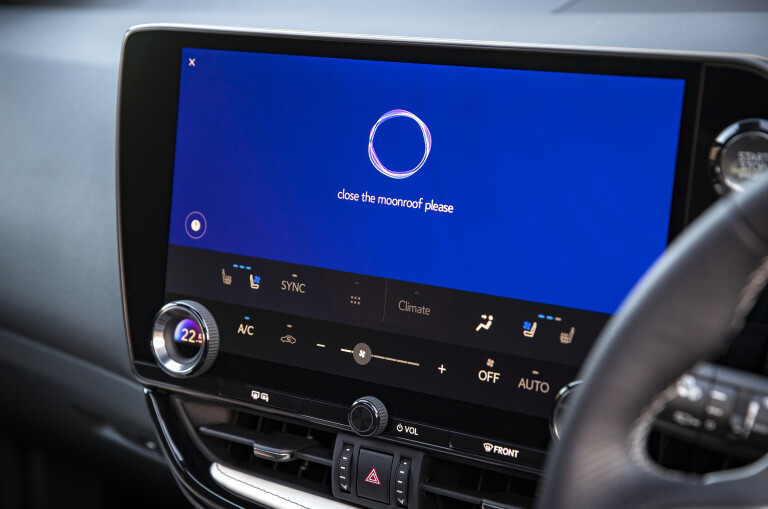
For example, if you want to open your window you say: 'Hey Lexus, open my window.' Because the system can tell where your voice is coming from, it will open the driver or passenger-side window depending on where you're sitting.
Jumping into the back seats, the second-generation NX benefits from a 2690mm wheelbase that's 30mm longer than its predecessor and affords good legroom for a mid-sized SUV. The seats are comfortable but headroom is compromised a little by the swept-back roofline – particularly when the panoramic sunroof is installed.
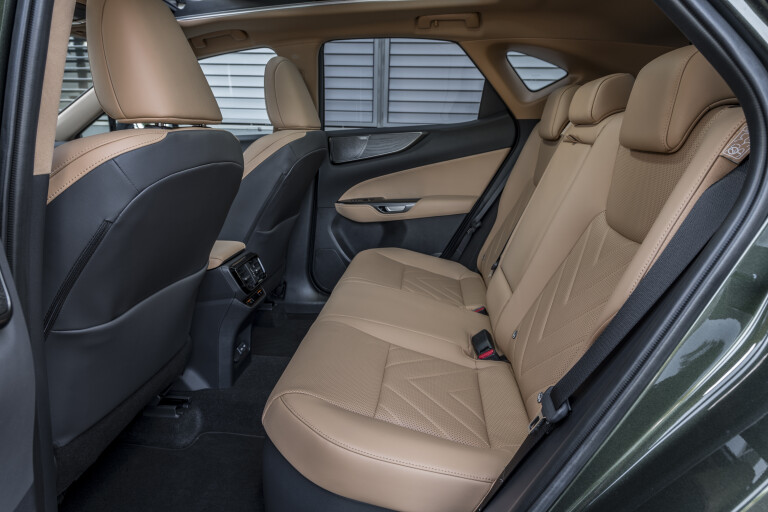
Unlike PHEV versions of some other models, the battery doesn't hamper boot space, which is 520 litres across the NX range. This is a 45 litres increase over the previous model, partly due to the absence of a spare wheel, with all variants now rolling on run-flat tyres.
I would prefer to see a spare wheel under the boot floor. A space-saver wouldn't compromise boot space too much and while run-flats are convenient when you get a puncture, they just delay the inconvenience of changing it and cost a lot more to do so.
Folding the second-row seats down extends cargo carrying capacity up to 1141 litres.
If you need to carry more, the NX450h+ has a modest 1000kg braked towing capacity, which is 500kg less than the hybrid but the same as the petrol variants.
On the Road
The NX 450h+ plug-in hybrid powertrain is based on the same 2.5-litre petrol engine of the NX 350h but with a slightly reduced output of 136kW/227Nm. It's supplemented by two permanent-synchronous motors, a 134kW/270Nm unit at the front axle and a 40kW/121Nm one at the rear, which combine to produce peak power 227kW, making it the most powerful NX variant to date.
Its 18.1kWh lithium-ion battery has one of the bigger capacities found in a plug-in hybrid, with the norm being around 13 to 15kWh. The downside of that is it will take longer to charge; about 2.5 hours at a 7.0kW AC wall box charger, or about nine hours on a standard 240-volt outlet.

There is no quicker AC charging option than 7.0kW, even if using a 22kW charger, and unlike the Mitsubishi Eclipse Cross PHEV there is no DC fast-charging option that can bring 80 per cent charging time down to about 30 minutes. I reckon if manufacturers are going to start putting bigger batteries in PHEVs they really should offer that as it makes charging on the go a lot more viable.
However, the extra battery power gives the NX450h a decent all-electric range of up to 87km, which in many cases will allow for emissions-free daily driving with enough juice left that it just needs a shortish top-up.
It also allows for a bit of spirited driving. With plenty of instant torque on tap, the NX 450h+ can sprint from 0 to 100km/h in a brisk 6.3 seconds, which is 1.4 seconds quicker than the NX350h AWD.
Despite its 2050kg kerb weight being 180kg more than the NX350h AWD, you can really feel the extra pep whether you're in all-electric EV-Priority mode, or the Auto EV/HV Mode that takes additional power from the petrol engine when needed, such as for overtaking.
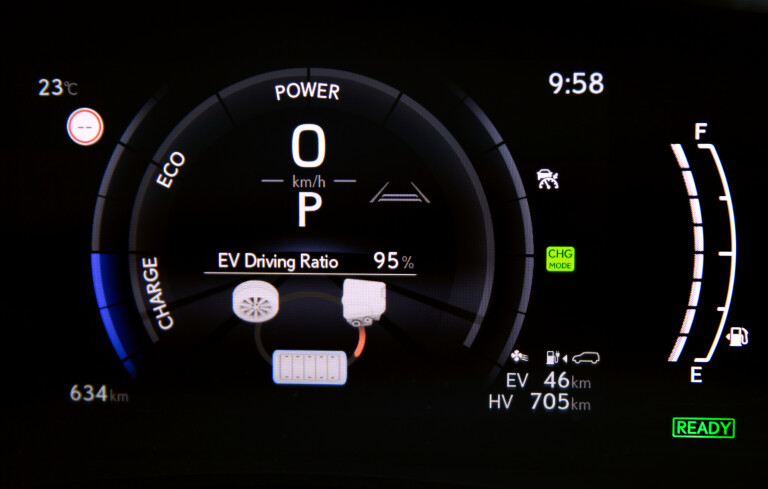
Whichever power mode you're in, the driving experience is quite delightful, with excellent pedal response backed up by the seamless operation of the electronically controlled continuously variable transmission (eCVT). That said, the 2.5-litre Atkinson cycle engine isn't the most refined powerplant in the Lexus range and it can sound gruff on those occasions when you do some petrol-fuelled oomph.
You can travel on batteries alone at speeds up to 140km/h, which of course will suck up your range as quickly as your demerit points. If you do run out of electrons the powertrain will automatically revert to HV (hybrid) mode, which operates just like the NX 350h so you won't be driving on engine power alone.
There is also a Battery Charging mode that uses the engine to both propel the vehicle and charge the battery using the 6.6kW onboard charger. This results in higher fuel consumption and seems counterproductive, but if used on an open highway where fuel consumption is most economical, it could allow you to drive in EV mode again once you're back on fuel-sapping city roads (or conscious of your contribution to urban air quality).
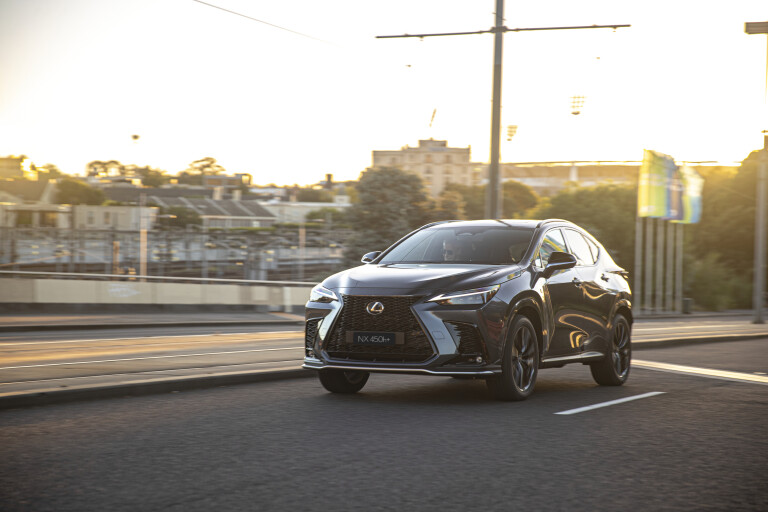
Each mode can be manually selected with buttons located on the centre console below the gear selector.
Unfortunately, my time with the NX450h+ at the launch was all too brief so I was unable to get a handle on fuel economy in the different modes – Lexus only provides a general combined fuel economy of 1.3L/100km, which assumes you're starting off with a fully charged battery.
The PHEV's additional heft means it drinks more in hybrid mode than the 350h AWD's 5.0L/100km, but any driving in EV mode during your trip will help balance things out.
One thing that disappointed me about driving on battery power alone was that it wasn't exactly a silent experience due to the tyre rumble. This is most likely due to the run-flat tyres, which have hard sidewalls that create a tinny sound. This was less an issue at higher speeds where engine noise would tend to dominate, with wind noise well contained.

The run-flats also make for a busy ride at slow speeds in some of the other NX variants, but the F Sport comes with adaptive variable suspension (AVS) and performance dampers, which irons out most surfaces.
It has Comfort and Sport S/Sport S+ settings and while the latter stiffens a little for improved handling dynamics it's still smoother than the ride on the standard suspension, which I experienced in the NX350h Luxury and Sports Luxury variants.
All in all, this offers a decent blend of ride comfort and handling, though the latter can be down is by the steering, which has a nice weight to it but lacks communication through the front wheels to the road, which initially saps confidence.
Safety
The 2022 Lexus NX brims with advanced driver assistance technology across all specification grades. Some of these, such as e-latch, safe exit assist, intersection turn assist (which operates the brakes to avoid a collision while turning) and emergency steering assist, are making their Lexus debut on this car.
Other safety features include Lexus Connected Services with SOS call, automatic collision notification and stolen vehicle tracking, autonomous emergency braking with pedestrian and daytime cyclist detection, auto high beam, parking support braking, blind-spot monitor, adaptive cruise control with traffic jam assist, lane-keep assist, road sign assist and a tyre pressure monitoring system.
The NX is also equipped with eight airbags including driver/passenger front, side, head and knee, front centre, and rear passenger head.
At the time of writing, the 2022 Lexus NX range had yet to receive an ANCAP safety rating.
The Verdict
With an EV driving range of 87km, the NX450h+ is demonstrating what plug-in hybrid vehicles have promised but have not always been able to deliver – a practical compromise between experiencing emissions-free driving and range anxiety.
The caveat of course is you need to be able to regularly charge your battery, preferably overnight at home, and Lexus has done well to throw in a 7kW charger as part of the deal, which installed represents about $2000 of value.

This makes the $9000 difference between this and the similarly equipped NX350h F Sport AWD with the Enhancement Pack 1 more palatable.
Before you push the start button, virtually nothing separates the two, which would make that price difference a little hard to justify when you're at the showroom.
However, if you can stretch your budget, there is certainly value in spending that much more for the ability to travel around 80km on batteries alone for a fraction of the cost of comparative BEV, such as the BMW iX3, which starts at $114,900 before on-road costs.
Then there's the fact NX450h+offers superior performance that's more likely to put a smile on your dial than the regular NX hybrid or NX350 turbo.
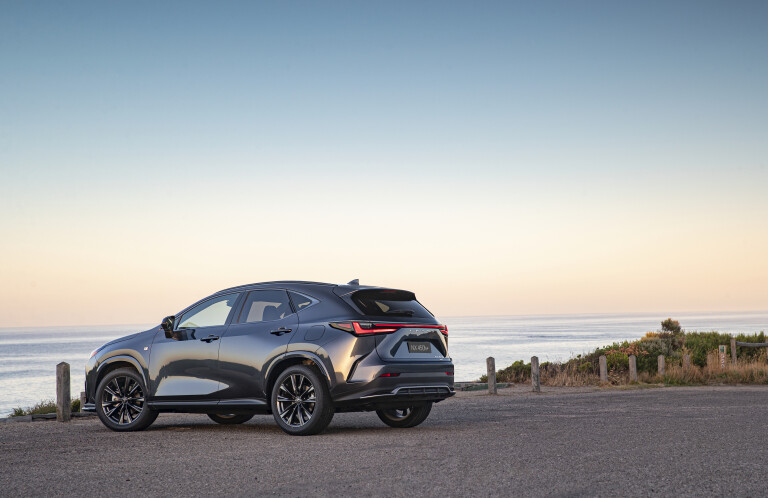
So yeah, while it's probably not the sweet spot of the range when factoring in pricing, it's certainly worthy of its flagship title.
As for the second-generation NX in general, despite the crisp new-look interior losing some of that unique Lexus flair, the new technology and attention to detail make for an overall package that exudes everything there is to like about the brand, not least the luxury driving experience.
Lexus NX450h+ F Sport specifications
| Model | Lexus NX400h+ F Sport |
|---|---|
| Engine | 136kW 2487cc 4cyl dohc 16v Atkinson-cycle |
| Drive | all wheel |
| Max engine power | 136kW @ 6000rpm |
| Max engine torque | 239Nm @ 4300-4500rpm |
| Motors | 134kW permanent-magnet synchronous front, 40kW permanent-magnet synchronous rear (AWD) |
| Max combined power | 227kW |
| Battery | 18.1 kWh |
| Bore x stroke | 87.5mm x 103.5mm |
| Compression ratio | 14:00:01 |
| Transmission | eCVT |
| 0-100km/h | 6.3sec |
| Economy | 1.3L/100km |
| Kerb weight | 2050kg |
| Dimensions L/W/H | 4660mm/1865mm/1670mm) |
| Wheelbase | 2690mm |
| Suspension | front MacPherson strut, rear trailing arm type double wishbone with adaptive variable suspension (AVS) and performance dampers |
| Brakes | front 328mm ventilated discs, rear 317mm ventilated discs |
| Wheels | 20.7.5J alloy |
| Tyres | 235/50 R20 runflats |
| Price | from $89,900 before on-road costs |
Score breakdown
Things we like
- Punchy plug-in hybrid powertrain
- Very useful all-electric range
- New infotainment technology
- Comfort and features
Not so much
- 7kW battery-charging limit
- Run-flat tyres
- Vagueish steering
- Only available in F Sport spec

COMMENTS